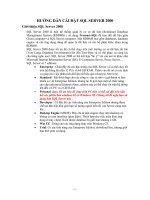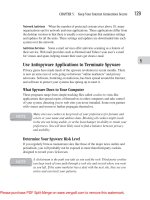Tài liệu How Computer Memory is Organized ppt
Bạn đang xem bản rút gọn của tài liệu. Xem và tải ngay bản đầy đủ của tài liệu tại đây (19.33 KB, 3 trang )
How Computer Memory is Organized
Computers use memory to hold programs being executed, and the data that these
programs use. In order to understand the differences between value and reference types, it
is helpful to understand how data is organized in memory.
Operating systems and runtimes (such as the common language runtime) frequently
divide the memory used for holding data into two separate chunks, each of which is
managed in a distinct manner. These two chunks of memory are traditionally called the
stack and the heap. The stack and the heap serve very different purposes:
• When you call a method, the memory required for its parameters and its local
variables is always acquired from the stack. When the method finishes (because it
either returns or throws an exception), the memory acquired for the parameters
and local variables is automatically released back to the stack and is available for
reuse when another method is called.
• When you create an object (an instance of a class) by using the new keyword and a
constructor call, the memory required to build the object is always acquired from
the heap. You have seen that the same object can be referenced from several
places by using reference variables. When the last reference to an object
disappears, the memory used by the object becomes available for reuse (although
it might not be reclaimed immediately). Chapter 13 includes a more detailed
discussion of how heap memory is reclaimed.
NOTE
All value types are created on the stack. All reference types (objects) are created
on the heap.
The names stack and heap come from the way in which the runtime organizes memory:
• Stack memory is organized like a stack of boxes piled on top of each other. When
a method is called, each parameter is put in a box which is placed on top of the
stack. Each local variable is likewise assigned a box, and these are placed on top
of the boxes already on the stack. When a method finishes, all its boxes are
removed from the stack.
• Heap memory is like a large pile of boxes strewn around a room rather than
stacked neatly on top of each other. Each box has a label indicating whether it is in
use or not. When a new object is created, the runtime searches for an empty box
and allocates it to the object. The reference to the object is stored in a local
variable on the stack. The run-time keeps track of the number of references to each
box (remember that two variables can refer to the same object). When the last
reference disappears, the runtime marks the box as not in use, and at some point in
the future will empty the box and make it available for reuse.
Using the Stack and the Heap
Now let's examine what happens when the following Method is called:
void Method(int param)
{
Circle c;
c = new Circle(param);
}
Suppose the value passed into param is the value 42. A piece of memory (just enough for
an int) is allocated from the stack, and initialized with the value 42. Inside the method,
another piece of memory big enough to hold a reference is also allocated from the stack,
but left uninitialized (this is for the Circle variable, c). Next, another piece of memory big
enough for a Circle object is allocated from the heap. This is what the new keyword does.
The Circle constructor runs to convert this raw heap memory into a Circle object. A
reference to this Circle object is stored in the variable c. The following graphic illustrates
the situation:
At this point, you should note two things:
1. Although the object itself is stored on the heap, the reference to the object
(variable c) is stored on the stack.
2. Heap memory is not infinite. If heap memory is exhausted, the new operator will
throw an OutOfMemoryException and the object will not be created.
NOTE
The Circle constructor could also throw an exception. If it does, the memory allocated to
the Circle object will be reclaimed and the value returned by the constructor will be a null
reference.
When the function ends, the parameters and local variables go out of scope. The memory
acquired for c and the memory acquired for param is automatically released back to the
stack. The runtime notes that the Circle object is no longer referenced, and at some point
in the future will arrange for its memory to be reclaimed by the heap (see Chapter 13).









